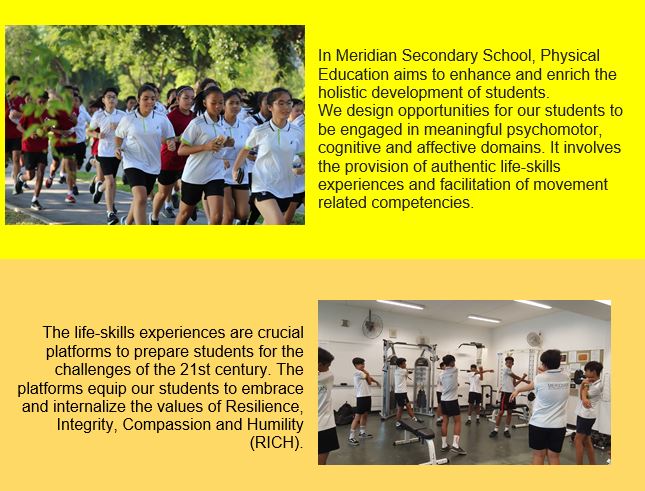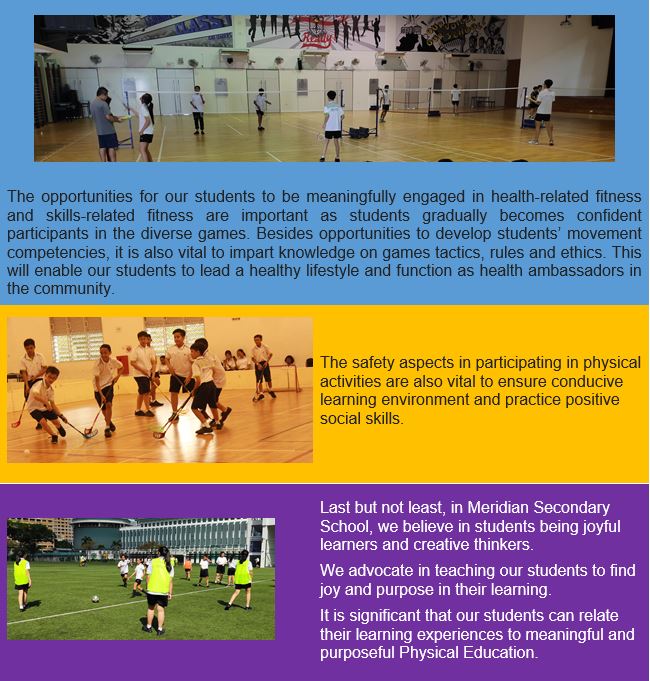Physical Education
Vision
Students are confident players, competent leaders and compassionate teammates who are able to lead a healthy lifestyle and contribute to community.
Mission
To equip students with psychomotor competencies, cognitive understanding and affective values in Physical Education.
Approach
We focus on two process-oriented outcomes:
- Develop Positive Classroom Culture.
- Establish positive interaction.
- Create strong Teacher-Student Rapport.
- Set expectations and routines.
- Deliver Quality Lesson Enactment.
- Arouse interest via explicit demonstrations.
- Focus on learner-centric engagement.
- Maximize student participation.
PE Curriculum
1. Content
In alignment with the PE Syllabus, we have identified six core games as part of goal-oriented activities to drive and deliver our outcomes.
The core games are categorized:
- Territorial-Invasion Games:
- Basketball
- Football
- Floorball
- Net-Barrier Games:
- Badminton
- Volleyball
- Striking-Fielding Game
- Softball
The additional core modules are:
- Physical Health and Fitness (PHF)
- Outdoor Education (OE)
For our graduating students, we plan for inter-class recreational games to enhance students’ games application and in addition, we also offer electives to broaden their games experiences:
- Ultimate Frisbee
- Tchoukball
- Lacrosse
- Touch Rugby
- Cricket.
2. Pedagogy
While we are flexible in pedagogical approach, we have incorporated Rink’s 4 Games Stages (2006) in the planning and teaching of Sec 1 to 3 PE content and geared towards a more constructivist approach for the graduating students.
- 4 Games Stages Approach:
- Stage 1: Ball Control (Object Familiarization)
- Stage 2: Combination of Skills
- Stage 3: Tactics
- Stage 4: Complex Game.
- Games Concept Approach (GCA): Combination of techniques and tactics in teaching, with the aim of getting students go through a ‘situational game’, ‘questioning’, ‘developmental focus’, ‘situational game’ and ‘game closure’.
3. Assessment
Assessment provides crucial information for making informed judgement about what the students know and are able to do in order to help them progress and attain the PE goals. We aim to provide a systematic formative and summative assessment and facilitate a balanced perspective on students’ overall progression via our Meridian PE Assessment Portfolio. The Learning Outcomes of each core game, OE and PHF have been identified and we have applied a number of assessment tools to provide standardization and consistency in our departmental practice.
| S/N | Core Games | Category | Assessment Tools | |
|---|---|---|---|---|
| 1 | Badminton | Singles | Net-barrier | Hit Map & Heat Map |
| 2 | Basketball | 3 vs 3 | Territorial-invasion | Heat Map & TSAP |
| 3 | Floorball | 4 vs 4 | Territorial-invasion | Heat Map & TSAP |
| 4 | Football | 5 vs 5 | Territorial-invasion | Heat Map & TSAP |
| 5 | Softball | 6 vs 6 | Striking fielding | Hit, Heat Map & TSAP |
| 6 | Volleyball | 4 vs 4 | Net-barrier | Hit & Heat Map |
- What do we expect our students to learn?
- Physical domain: students learn to be physically active, ability to demonstrate meaningful motor responses.
- Cognitive domain: students learn to understand tactics and strategies to orientate meaningful decision-making.
- Affective domain: students inculcate positive values, demonstrate these values during performance.
- How will we know when they have learnt?
- In PE, learning can be inferred from a student’s behaviour or performance.
- PE content has identified learning outcomes.
- PE teachers design tasks and assessment to elicit student’s responses in relations to the learning outcomes.



